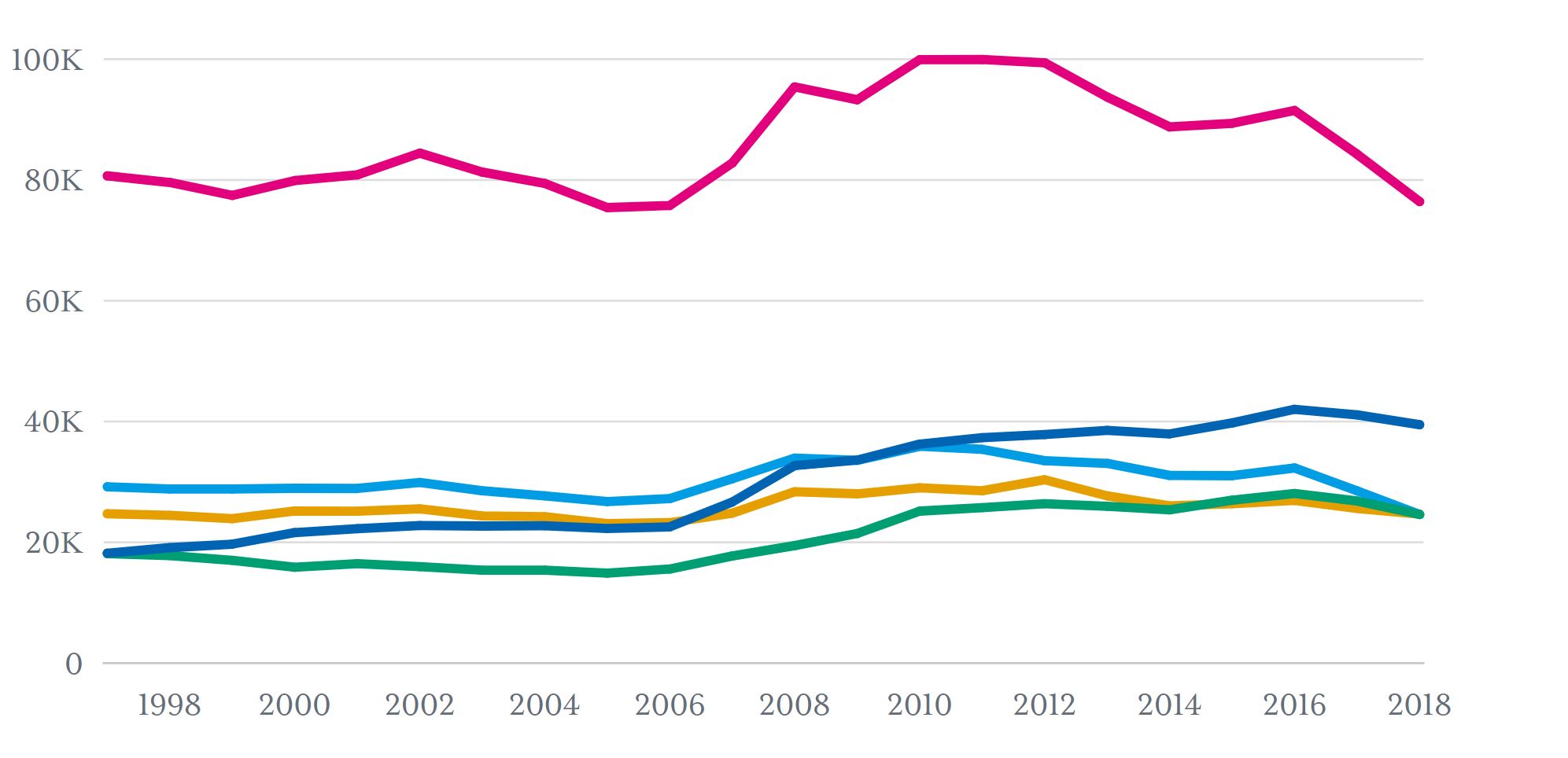Population
Ahead of Supreme Court hearing, here's a look at the data on LGBTQ workplace discrimination cases

The National Recording Registry (NRR) preserves the voices of influential American musicians, the speeches that gripped the nation during times of crisis, and field recordings of Indigenous people and their customs, among many other works.
The Library of Congress, which oversees the registry, inducts recordings based on their historical, cultural, or social relevance. The result is a repository of over 600 works and titles that preserves cultural milestones for future generations.
The NRR has compiled 610 audio recordings across 23 genres since it began inducting entries in 2002. Recordings date as far back as the 1890s, while the newest entry is from 2010.[1]
Passamaquoddy Indian field recordings from 1890. They are the oldest existing audio recordings of traditional Native American music.
The most recent entry by year is not a song, but a podcast interview between comedians Marc Maron and Robin Williams on April 26, 2010. This entry was notable for not only helping to popularize the podcast medium before it had achieved mainstream success, but also memorializing an intimate conversation with the late Mr. Williams.
The broadcast and spoken recordings encompass the widest spectrum of entries. Examples include President Franklin D. Roosevelt’s “Fireside Chats,” Reverend Martin Luther King Jr.’s “I Have a Dream” speech, and a New York City public radio broadcast from September 11, 2001.
The registry also contains notable songs and albums stretching back to the early 20th century. This includes “Dark Was the Night, Cold Was the Ground” by Blind Willie Johnson, a copy of which was placed aboard the Voyager I and II spacecraft in 1977; “This Land is Your Land” by folk poet Woody Guthrie; Dance Mania by Latin-American mambo and jazz composer Tito Puente; Thriller, the best-selling album of all time by Michael Jackson, and The Miseducation of Lauryn Hill by Lauryn Hill.
The registry also includes music by artists outside of America, such as Lovely’s Trinidad String Band in 1912, The Beatles in 1967, and Radiohead in 1997, among others.
The registry’s most common genres are broadcast/spoken word, pop music from 1955 to 1975, and classical/opera.
Some traditional American genres, such as jazz, country/bluegrass, blues, and rap/hip hop fall lower on this list.
1959 spawned more NRR inductees than any other year, with a total of 19 recordings. Entries include Kind of Blue by Miles Davis, Time Out by the Dave Brubeck Quartet, and Gunfighter Ballads and Trail Songs by Marty Robbins.
The next most common years are 1938 with 16 entries, such as Louis Armstrong’s “When the Saints Go Marching In,” and 1964 with 15 entries, including the original Broadway cast recording of Fiddler on the Roof.
Most NRR titles come from the 1960s, an influential period of American musical innovation. Social movements during this decade, such as the Civil Rights Movement, gave rise to songs and albums emphasizing themes of activism, unity, and counterculture in popular music.
With each new year of entries, the NRR inducts more titles from the 1980s, 1990s, and 2000s and currently underrepresented genres, such as Latin, pop from 1996 and later, and rap/hip-hop.
The registry has a broad range of entries outside of traditional music genres. Its sports category includes a recording of Hank Aaron’s 715th career home run, and the children’s category covers a mix of melodies for America’s youth, with songs from Mr. Rogers Neighborhood and Sesame Street, among others.
The registry also includes notable technologies which have revolutionized audio recording, stretching back as far as 1853.
Any member of the public can submit up to 50 registry nominations a year. The Library of Congress and members of the National Recordings Preservation Board evaluate the year’s nominations and narrow them down to approximately 25 picks.
Finalists selected for approval should encapsulate a cultural, historical, or aesthetic milestone in American history.
Nominations can range from a single song or collection of works and may contain music, non-music, spoken word, or broadcast sound. No recording is eligible until ten years after the recording was released.
Do you have an opinion on the recordings that define the America’s history? Submit nominations for this year’s list visit the National Recording Registry.
Learn more about government structure and civil life, and get the data directly to your inbox by signing up for our newsletter.
Entries for audio recording technologies go as far back as 1853.
Population
Population
Population
Population
Newsletter
Keep up with the latest data and most popular content.


